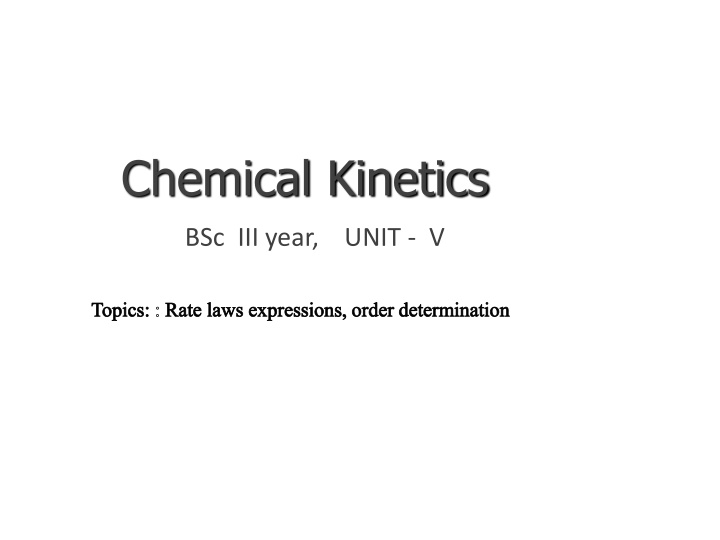
Chemical Kinetics: Rate Laws, Expressions, and Order Determination
Explore the fundamentals of Chemical Kinetics in BSc III year, focusing on rate laws, expressions, and order determination. Learn how reaction rates vary with concentrations, the significance of rate laws, and how to determine reaction orders experimentally.
Download Presentation

Please find below an Image/Link to download the presentation.
The content on the website is provided AS IS for your information and personal use only. It may not be sold, licensed, or shared on other websites without obtaining consent from the author. If you encounter any issues during the download, it is possible that the publisher has removed the file from their server.
You are allowed to download the files provided on this website for personal or commercial use, subject to the condition that they are used lawfully. All files are the property of their respective owners.
The content on the website is provided AS IS for your information and personal use only. It may not be sold, licensed, or shared on other websites without obtaining consent from the author.
E N D
Presentation Transcript
Chemical Kinetics BSc III year, UNIT - V Topics: : Rate laws expressions, order determination
Concentration and Rate Each reaction has its own equation that expresses its rate as a function of the concentrations of the involved species (e.g., reactants, products, catalysts). This is called its Rate Law
Rate Law In general, rates of reactions increase as concentrations increase since there are more collisions occurring between reactants. The overall concentration dependence of reaction rate is given in a rate law or rate expression. For reactions follow simple rate laws: v = k [A]m [B]n - [A], [B]: reactant concentrations - The exponents m and n: reaction order (w.r.t. specific reactant) - The constant k: rate constant - The overall reaction order is the sum of the reaction orders: m + n
Rate Laws Rate laws, rate constants, and orders are determined experimentally. The order of a reactant is NOT generally related to its stoichiometric coefficient in a balanced chemical equation. F2(g) + 2ClO2(g) 2FClO2(g) 1 v = k [F2][ClO2]
Simple and complex rate laws Reactions with simple rate laws: Reactions with complex rate laws*: * imply multi-step reactions (sequence of elementary steps) however, the overall rate cannot involve intermediate species
Elementary reactions Always follow simple rate laws Reactant order reflects molecularity (activemolecules involved in reaction) More on this later
Rate Law Example Consider the following reaction: NH4+(aq) + NO2-(aq) Let s say that the following observations from several experiments were made as [NH4+] doubles the rate doubles with [NO2-] constant. as [NO2-] doubles the rate doubles with [NH4+] constant. N2(g) + 2H2O(l) The rate of this reaction would be expressed as . Rate = k[NH4+][NO2-] The reaction is said to be first order with respect to [NH4+] and first order with respect to [NO2-]. But the overall order of the reaction is said to be second order. Reaction rates come from experiment data, not stoichiometry!
Concentration and Rate This equation is called the rate law, and k is the rate constant.






















